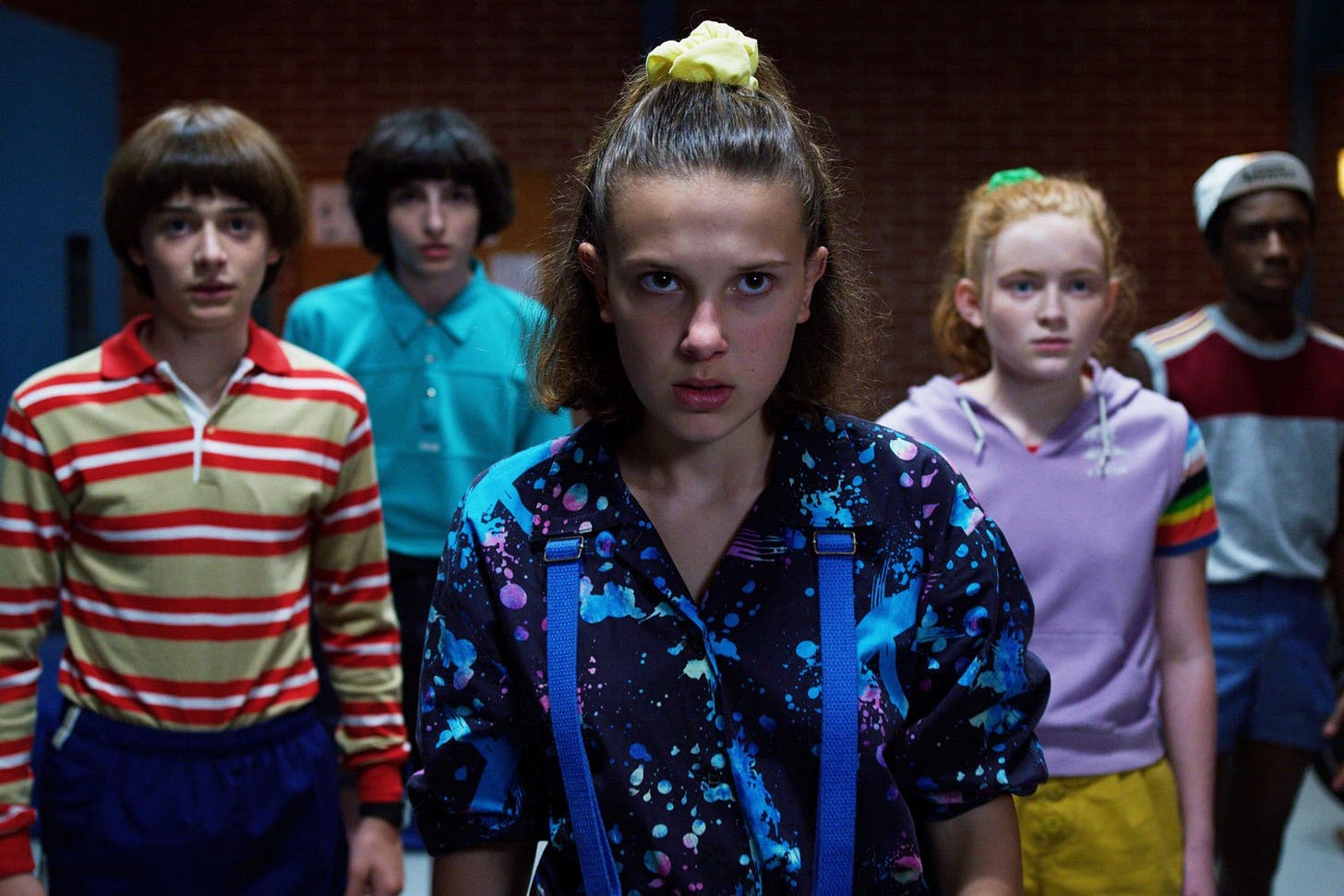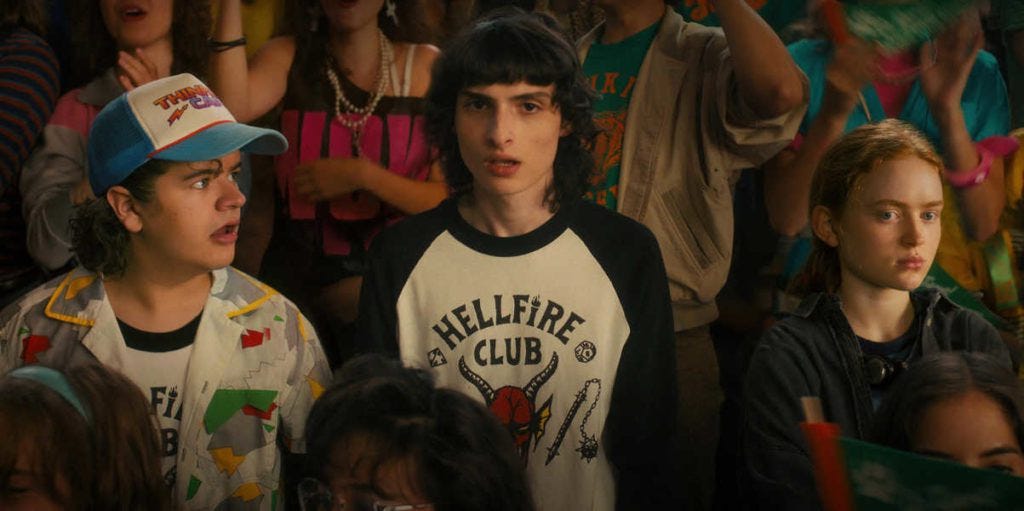Stranger Things' Problem with Diversity
Stranger Things is one of the most successful shows on Netflix, but how does it handle its diverse characters?
Hello, folks! We’re back with our regular schedule. This time, you’re reading the newsletter later in the month because I had to put my writing on the side for a while - dissertation stuff, you know. Anyway, a few new people subscribed in the last weeks so: thank you for trusting the project! Every interaction counts, and I am so very grateful for each one of you.
As announced back on Instagram, this time we’ll delve into the God-forsaken world of Stranger Things.
Bye for now, see you on the other side of the divider😌
Stranger things’ problem with diversity.
“God bless America”.
Stranger Things first aired in 2016 on Netflix. Since then, the Internet has been flooded with fan theories, video edits, fanfictions and other forms of audience participation that originated from a very malleable, evolving fanbase. Everyone can, virtually, be a ST fan: from the teen, to the fifty-year-old who has peaked in high school.
We, as the viewers, were presented with a 80s-inspired, fictional world in which every kind of American nostalgic fantasy could settle and grow into something much more real. Through the E.T-esque group of young protagonists and the buzz-cut hero with a number for a name, the audience could navigate a world that has a lot to offer - reassurance, comfort and action.
Four seasons and four diegetic years later, we are now dealing with a great example of what Netflix has produced for us: an empty box.
Regarding the space, every season had its distinctive environment: in the first season, it was the school; in the second one, it was the labs; the third one had the mall; the fourth one has the russian prison camp. The story has grown together with its characters, its lore and USA themselves. We’ve reached the point where every aspect of the production has reached its point of no return, and one of these is definitely the supposed diversity of its cast.
Characters: performative diversity.
If we were to list the diversity quota of Stranger Things, we would say the cast has a black character (Lucas), a disabled one (Dustin), a supposed homosexual (Will, even if not confirmed yet) and a lesbian (Robin). All of them have a ton of screetime, and the audience spends enough time with them to create significant emotional connections: Lucas, Dustin and Will are main characters and co-protagonists, while Robin has a very improtant role in Season 3, the one of her first appearence. All of them have agency, opportunities and conflicts to deal with. At least, until Season 4.
If we only look at the cast within these margins, we got ourselves a much fullfilling picture. We have every ingredient to call the production progressive, LGBTQ+ friendly and absolutely not racist. In fact, racism and homophobia (or a generic sense of how it was, to be black, queer or disabled in 1980s USA) don’t exist in the ST universe, and that plays along with the fact that the production doesn’t want to be historically accurate: it wants to convince you that everything was good in the past and you should rely on it, dream about it, buy your way into it. It operates around residuality.
It’s also a sci-fi, horror tv show in which kids use Dungeons & Dragons to identify the monsters that are trying to exterminate the human race. This also explains a lot.
Apart from this, the production surely has its fair share of “diverse visbility”, but doesn’t do as well regarding the other side of it: complex and satisfying representation.
The protagonist is a white girl. Her love interest is a white boy. The disabled character is white, as the two queer ones. Every adult protagonist is, indeed, also white. Even the villlain is white.
Even if we accept the fact that not every story needs to be 100% representative of every single human experience, it doesn’t cancel out the subsequent point: Stranger Things doesn’t fully let its diverse characters (that the writers decided to create) be. They are there, but they exist within the limits of normativity: if they’re black, they’re heterosexual; if they’re queer, they’re white; if they’re disabled, they’re also white. There always needs to be something that gets them closer to what is perceived as normal.
Characters: profitability of the diverse.
We mentioned the fact that Stranger Things’ protagonists in supposedly diversified. What we also need to point out is that, in said group, the only black and disabled characters have been confined to the sidekick/comic relief sphere: Dustin is the brain and his intelligence, curiosity and watchful eye saved the others on many occasion; Lucas, on the other hand, is kind and generous, and with a greatly developed sense of judgement. If Dustin is the explorer, Lucas is the most prone to conservatorism. He wants to fit in - in fact, he needs to fit in. That’s why, in Season 4, he is the one who leaves the group to try and pursue his basket career (sounds familiar…). Meanwhile, Dustin is the one who does not want to fit in and makes his and his friends’ presence in the Hellfire Club possible. He is, indeed, the one that convinces Eddie to not slit Steve’s throat open, in Episode 2.
It’s already clear that Dustin, althought ab-normal in his disability, is the one that retains the most agency. On the contrary, in Season 4, Lucas is only active in regards of the others and his former romantic involvement with Max, now threatened by Vecna. As a more indipendent, more pro-active character, we have his sister Erica. It can’t be said for sure, but it seems like ST can only manage one productive black character at a time.
This curious combination of “Lucas out/Dustin in” could be reduced to our will to seek poison in a place where there’s none. It could be a coincidence, it could be that Season 4 Part 2 will make it so that Lucas will have his final breakthrough (probably an hetersexual one), and it could be that Will Byers will finally make his canonical coming out - but what about Robin?
Robin made her big came out as a lesbian in Season 3, to Steve Harrington and Steve Harrington only. This makes her the only canonically queer character, but also a textbook case.
Even though Robin keeps her first row spot in Season 4, as a member of the Not-Exactly-Adult-Yet Gang, her character has an evident decline from right after her coming out (back in Season 3); that moment of dramatic effect and emotional connection between her and Steve makes her vulnerable in a place and time in which her very survival is at stake: not only is she risking her short-term safety in following the others in their supernatural adventure, but she’s also trusting her co-worker and schoolmate enough to let him know that she is one of the things that society fears the most. However, the scene in question has a positive outcome for her: by being herself, she is fully accepted in the group and can live up until the next season. Nonetheless, in said next season, Robin starts to loose her centrality and soon becomes a source of comic relief. The role that Dustin had in Season 1 and 2 is now hers.
Although Robin is not fully stripped of her agency, and we often see her tag along with Nancy, Steve and Eddie, she mostly acts like a pet or companion. At Pennhurst Mental Hospital, Robin is forced to wear clothes and a hairdo that make her visibily uncomfortable, which plays as a counterpoint for Nancy’s smart, elegant attitude and approach. This sequence, in Episode 4, in just one in a long list of moments in which Robin’s weirdness is highlighted. This wouldn’t be a problem, if it wasn’t for the fact that this is the only way in which she is presented to the audience, in the latest season. Her queerness is directly connected to her ab-normality and her innate predisposition to unsuitability. She’s playing a role very close to the one of the trickster, in which she uses her unsuitability to save the situation and get closer to her objective - as seen at Pennhurst Mental Hospital. But her objective is not truly hers. In fact, the potential positive outcome is cut at the root by the real beneficiary: Nancy, the socially acceptable one.
All of the characters just mentioned have something in common: their actions are, ultimately, not aimed to their individual development nor the story per se, but always towards the betterment of the Most-Normal of the case.
Dustin is the only exception because he actually is the propellor of the story. However, him being the exception can be explained by focusing on the normalisation of his physical appearence. For example, he is not shown to the audience without his dentures anymore, and this can be explained by further focusing on his age: he is now too old and childhood is a barrier behind which he can no longer hide. Notice that, even if dentures have their fundamental functional purpose, in a tv show like Stranger Things they can only be an aesthetic tool… just like diverse characters.
We’re at the end, again. Thanks for reading the Crip 101 Newsletter of June and I hope you are finding your way through this hellish heath.
Remember that you can support Crip 101 by talking about it with your English-speaking friends, checking the weekly updates on our Instagram page (@cr.ip101) or sharing this article wherever you fancy!
See you in the next one🔥






